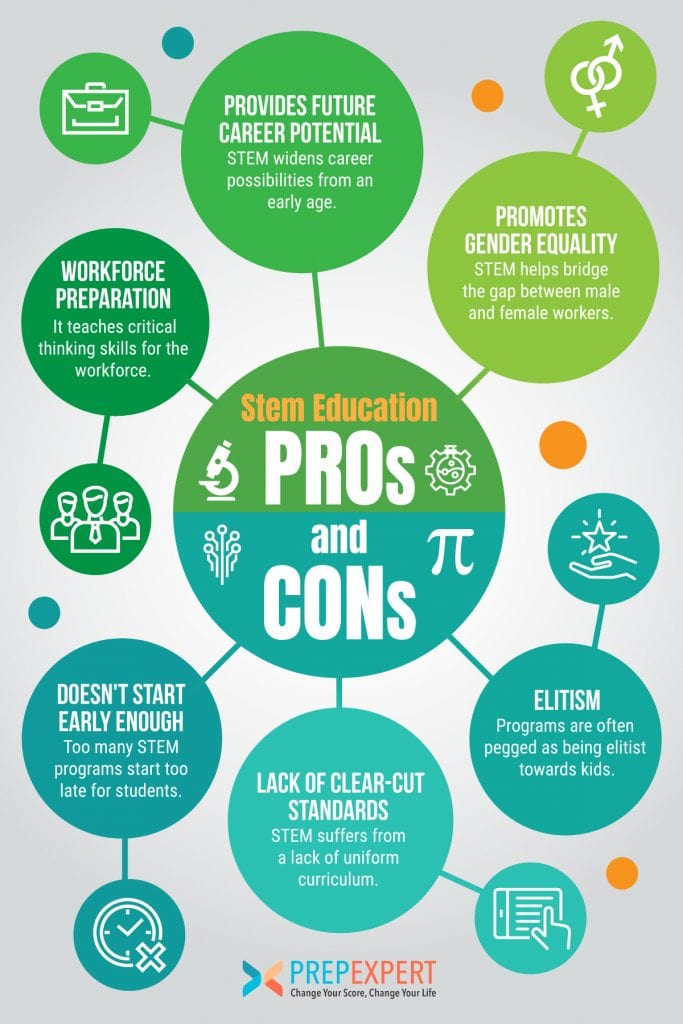STEM Pros And Cons
Many educators today talk about STEM programs in public education as a benefit. STEM (Science, Technology, Engineering, and Mathematics) is a method that combines difficult subject matter in these areas with real-world scenarios to help inspire more students to pursue those careers. As with anything else, there are STEM pros and cons to consider.
Here are the various STEM pros and cons to consider before enrolling in a STEM-related high school program or college major.
Learn how to prepare for standardized tests with our year-round SAT prep and ACT prep courses today.
STEM Education Pros
Workforce Preparation
The most popular STEM argument is that it prepares students for the workforce.
STEM teaches students critical thinking and innovation skills. These particular skills help tremendously in the workforce. Science and Math naturally lend themselves to these particular skill sets too.
Moreover, high school STEM programs are normally hands-on and challenging, which pushes students to develop independent thought and initiative to succeed. Seasoned professionals often come in and work with students to provide real-world exposure to future career options.
Promotes Gender Equality
STEM is attempting to bridge the gap between male and female workers.
In STEM-related careers, a sizable gap exists between the numbers of female versus male workers. Approximately 24% of current STEM career workers are female.
STEM proponents argue that by bringing in young girls at an earlier age to these subjects and developing their interest, this gap will positively reduce over time. Furthermore, STEM learning provides equal opportunity and coaching for everyone.
Provides Future Career Potential
STEM widens career possibilities from an early age.
There are many potential careers out there for students to choose from. An important factor to consider though is how in-demand certain careers are at certain points in time.
As with anything else, industries can boom and bust just like a pop-cultural phenomenon. Students with STEM-based educations though enjoy nearly endless job opportunities. Why?
Because the demand for that education is always present in the workforce, from engineers to programmers to doctors and scientists. These careers also offer usually offer above-average salaries and benefits to workers within them.
STEM Education Cons
Lack Of Clear-Cut Standards
STEM suffers from a lack of uniform curriculum.
The biggest issue plaguing STEM education at large is the lack of uniform guidelines for what students should learn or what qualifications teachers require for hiring. Every program at every STEM school is different.
While they provide a foundational base, there’s no consistency regarding emphasis placed on specific subjects or skills. The risk is that parents enroll their students into a STEM high school in hope of them getting into dream schools, and find out they weren’t prepared enough.
Furthermore, with no STEM-specific teaching qualification in place, there’s fear that some teachers may not be fully qualified to teach in certain areas.
Doesn’t Start Early Enough
Too many STEM programs start too late for students.
The earliest time where STEM programs become available for students in middle school. Many program opponents feel that this time is already too late for students, consequently, they won’t develop the necessary passion and motivation to succeed.
STEM subjects are not easy; they’re challenging and, as such, need to cultivate significant interest within kids as early as possible. The earlier students are exposed, the better their chances are of sticking with it.
Unfortunately, that would mean having elementary school-level STEM programs, which right now is not a realistic possibility.
Elitism
STEM programs are often pegged as being elitist towards kids.
STEM programs cater better to students who are naturally motivated and prepared to succeed. Students who do not fit those criteria are often left behind.
As a result, STEM programs often won’t cater to lower-achieving students, even though those very same kids could be just as successful as their counterparts with additional help.
For more test strategy, college admissions, and scholarship application tips sign up for our FREE class happening right now!
STEM Pros And Cons FAQ
What does STEM stand for?
STEM is an acronym that stands for Science, Technology, Engineering, and Mathematics.
What’s the most common pro for STEM programs?
The most popular STEM argument is that it prepares students for the workforce. STEM teaches students critical thinking and innovation skills. These particular skills help tremendously in the workforce.
What’s another STEM education benefit?
Students with STEM-based educations though enjoy nearly endless job opportunities. Why? Because the demand for that education is always present in the workforce, from engineers to programmers to doctors and scientists. These careers also offer usually offer above-average salaries and benefits to workers within them.
What’s the biggest problem with STEM programs?
The biggest issue plaguing STEM education at large is the lack of uniform guidelines for what students should learn or what qualifications teachers require for hiring. Every program at every STEM school is different. While they provide a foundational base, there’s no consistency regarding emphasis placed on specific subjects or skills.
